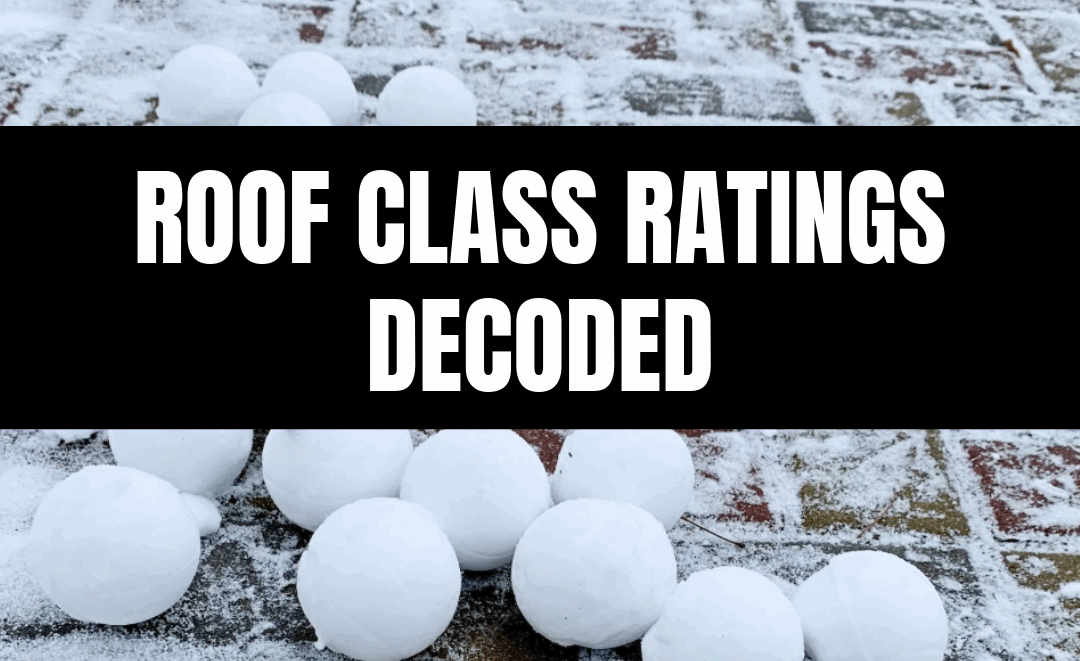What Is a Class Rating? Understanding the UL 2218 Impact Test & Other Classes
What UL 2218 Means
- Underwriters Laboratories (UL) developed UL 2218, a standard test measuring impact resistance of roofing materials. Essentially, steel balls of a specific size are dropped from certain heights onto sample shingles at vulnerable spots (edges, joints, unsupported areas). The shingle is examined for cracks, splits, ruptures, or failures.
- Different “Classes” indicate different levels of impact resistance. The higher the class, the more severe the impact the shingle should resist without damage. UL 2218 Class 4 is the highest available rating under that standard.
What Are the Classes?
Here’s a breakdown of UL 2218 classes (important to know for comparing products):
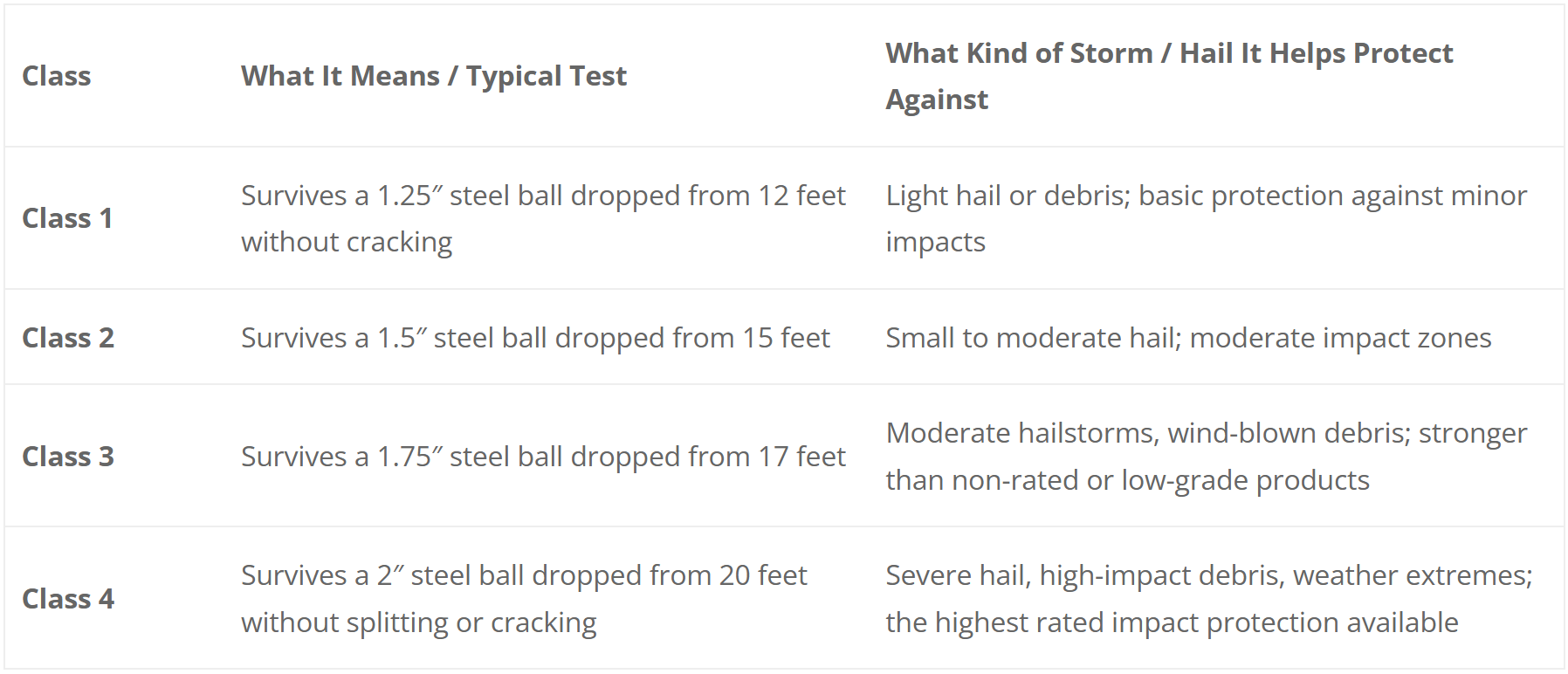
In this blog, we’ll focus on what Class 3 and Class 4 mean for Landmark Pro & ClimateFlex.
What Class Are CertainTeed Landmark Pro & ClimateFlex?
Let’s get specific about how Landmark Pro and ClimateFlex compare when it comes to class / impact rating, based on manufacturer data and certifications.
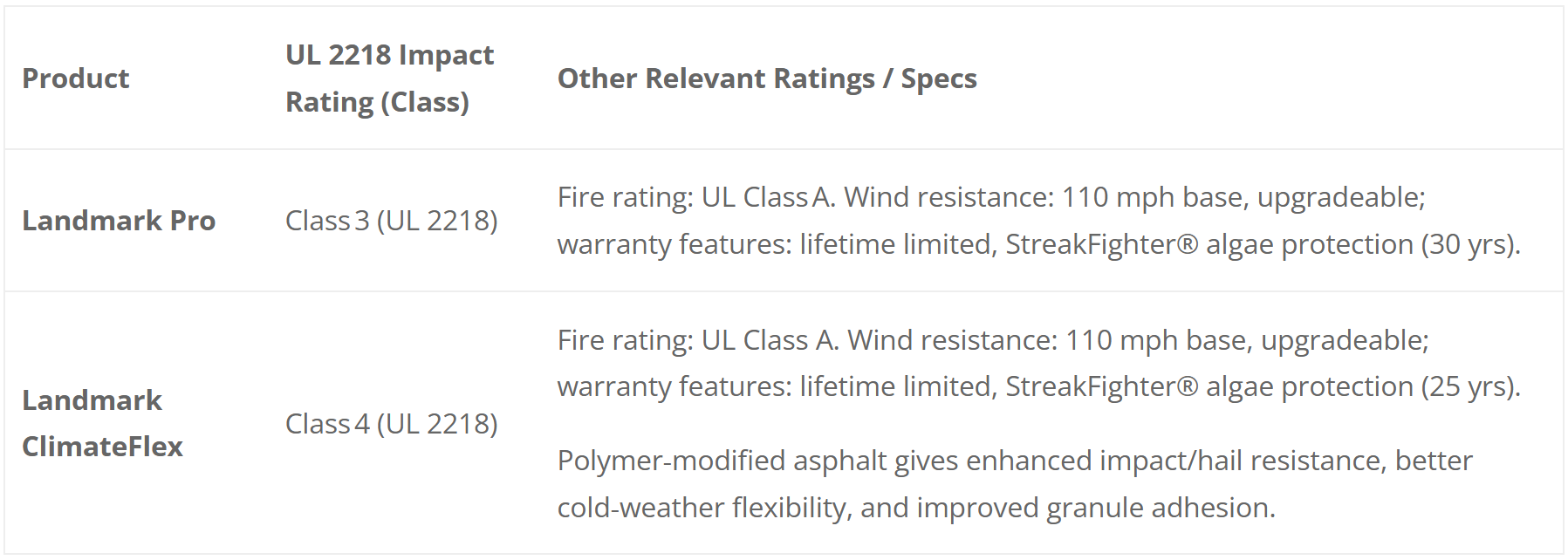
Other Performance & Class‑Related Specifications
Knowing the Class rating is one piece; shingles also need to perform well in other areas to truly deliver value.
Here are related specs to consider:
- Fire Resistance: Both Landmark Pro and ClimateFlex have a UL Class A fire rating (highest level) — important if your area is subject to wildfire risk or strict fire codes.
- Wind Resistance: Both offer about 110 mph base wind warranties; many products can be upgraded to 130 mph with certain installation conditions (starter strip, hip/ridge, etc.)
- Algae/Streak Resistance: Landmark Pro has strong algae resistance via StreakFighter with a 30-year warranty; ClimateFlex also carries that, though the warranty duration is 25 years. Helps preserve appearance, especially in humid or shaded areas like in Missouri / southern Illinois.
- Shingle Flexibility in Temperature Extremes: ClimateFlex’s polymer‑modified asphalt helps maintain flexibility in cold weather, reducing the risk of cracking.
Why Class Ratings Matter Especially in Missouri & Illinois
If you live in Ballwin, Chesterfield, O’Fallon, Belleville, Swansea, or any of the surrounding areas, these class ratings are more than marketing—they influence real outcomes.
Here’s what local factors make Class 3 vs Class 4 a meaningful distinction:
Hail & Storms
Missouri especially sees regular hailstorms; southern Illinois can too. Roofs that are Class 4 resist hail damage better, meaning fewer repairs after storms.
Insurance Considerations
Many insurance companies offer discounts or lower premiums for roofs with recognized impact ratings (Class 4 in particular). In some MO or IL zip codes, having a Class 4 UL 2218 roof may qualify for a premium reduction. Always check locally.
Maintenance & Repair Costs
Even if a roof is Class 3, if it is frequently struck by hail or debris, there may be cosmetic damage, granule loss, etc. Class 4 can reduce the frequency and severity of damage, saving money over time.
Resale Value & Buyer Confidence
A Class 4-rated roof is something potential buyers may see as less of a liability; less chance of visible damage or wear.
Climate Extremes & Seasonal Stress
Freeze‑thaw cycles, heavy ice/snow in winter; high heat/sun in summer—all these degrade shingles faster. A more impact‑resistant, flexible shingle helps in bridging weather extremes without material failure.
👉 Not sure what hail damage looks like? Spot the signs early with this Hail Damage Guide.
Differences Between Class 3 & Class 4: What You Get & What You Don’t
To help you decide, here’s a side‑by‑side comparison of what you would actually gain (or trade off) when going from a Class 3 (Landmark Pro) to a Class 4 (ClimateFlex) roof.
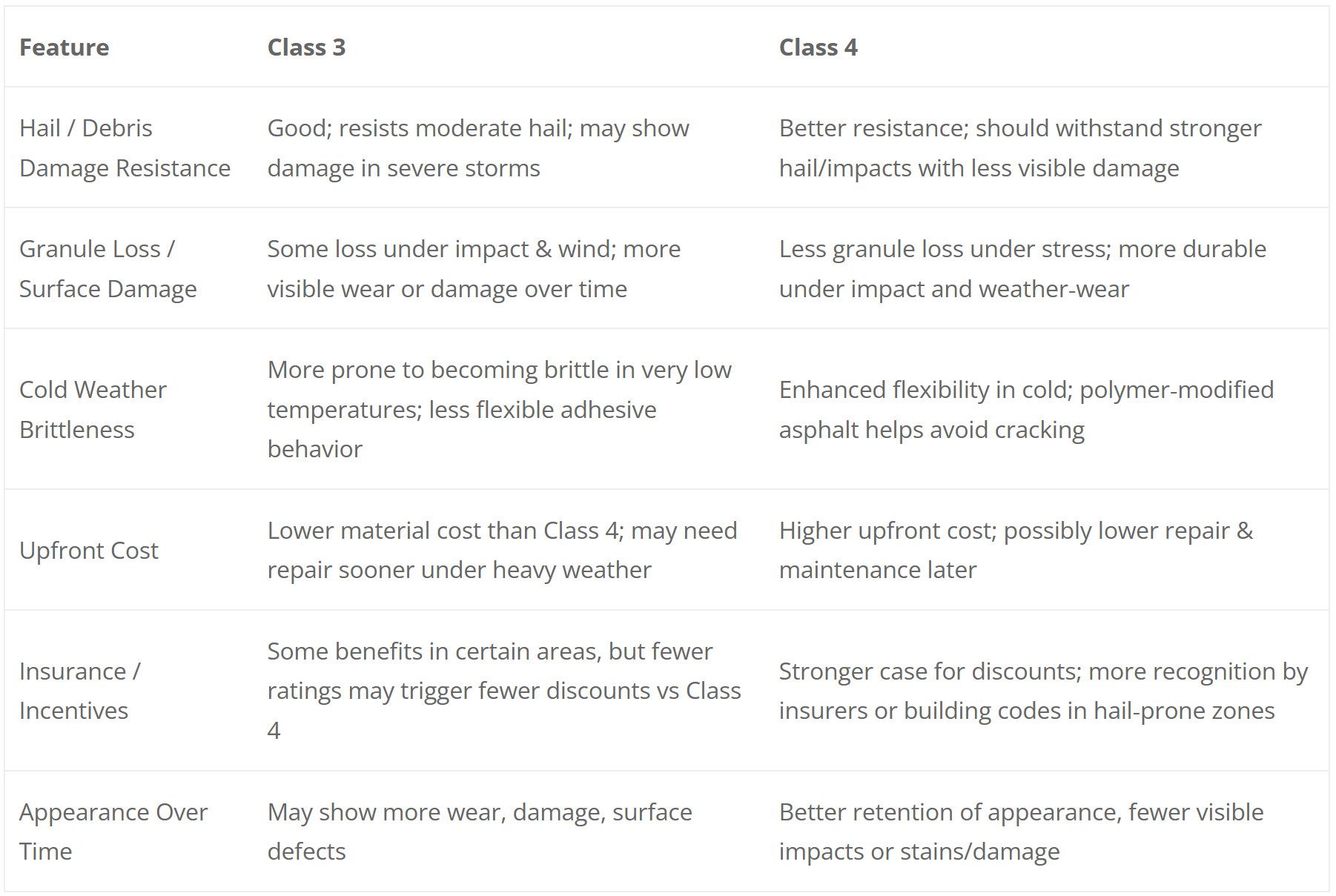
Real‑World Certification Notes & Recent Changes
- Landmark Pro: As of 2022 (“Landmark Pro products manufactured in 2022 and beyond”), CertainTeed announced that Landmark Pro shingles are UL 2218 Class 3 Impact Rated, and are currently working to get the Class 4 certification.
- ClimateFlex: Certified UL 2218 Class 4. Also validated by PRI for meeting Class 4 requirements when installed over a suitable deck substrate.
These certification details matter: when purchasing, verify the packaging / spec sheet to make sure the version you get is correctly rated. Sometimes older inventory may have different specs, so always check.
How UL 2218 Testing Is Done & Why It’s Strict
Understanding the test helps you see why Class 4 costs more and what performance it promises.
- UL 2218 testing involves dropping steel balls from specific heights onto samples at the most vulnerable points (edges, joints, seams). If there is cracking, splitting, or visible breakage, the sample fails.
- For Class 4, the highest standard in many residential shingle lines, the test uses a 2‑inch steel ball dropped from about 20 feet. The product must remain intact.
- Additional tests like wind resistance, fire rating, etc., are separate but often required together for full warranty/insurance benefit.
What to Look for When Buying: Ensuring You Get the Rating You Want
When you decide you want Class 3 vs Class 4, or you want the protection of ClimateFlex, here’s what to check and verify:
- Product Specification Sheet / Label
Ensure the shingles are indeed identified as UL 2218 Class 3 or 4. Many manufacturers include this on packaging/spec sheets. Check that the Landmark Pro version you are considering is the 2022+ production if it claims a Class 3 rating. - Installation Requirements
To maintain ratings/warranty, certain installation practices are required (proper starter strips, hip/ridge caps, underlayment, ventilation, correct nailing, etc.). If you cut corners, you may void some of the protection. - Substrate / Deck Requirements
Some ratings are conditional on a minimum sheathing/deck thickness (e.g., plywood of specified thickness) or condition. ClimateFlex’s PRI listing requires a minimum deck thickness. - Local Building Codes / Insurance Requirements
Some codes or insurers may require or recognize Class 4 impact ratings. Before investing extra, check with your local building department (e.g., for St. Charles County, St. Louis County, Belleville, etc.) and your insurance agent. - Contractor Qualifications
Use a roofing company that is certified or experienced in installing CertainTeed products; misinstallation can fail, even if the material is top class.
👉 Getting a Class 4 roof? Here’s how to protect your warranty by avoiding common installation and documentation mistakes.
Cost vs Benefit: Is Upgrading to Class 4 Worth It?
You’ve seen the specs—now, does that extra protection merit the extra cost? In many neighborhoods in Missouri / Illinois, yes—but with caveats.
- Extra cost for Class 4 (ClimateFlex) often comes with higher material cost, possibly higher labor, and maybe longer lead times. But the benefits include reduced repairs after hail / storm damage, less cosmetic damage, possibly lower insurance premiums, better durability under harsh weather, and stronger resale appeal.
- In areas with frequent hail (for example, around O’Fallon, St. Charles, or western parts of Missouri), the risk of damage from storms is high enough that many homeowners recoup that cost sooner.
- If your home is in a relatively low‑risk zone (rare hail, mild winters, good roofing maintenance), the difference might be less dramatic—but still, Class 4 gives more “buffer” for unexpected weather.
What Class Rating Doesn’t Guarantee
Even a high‑class rating like Class 4 has limits. It’s important not to expect perfect immunity.
- Class 4 resists impact in the UL 2218 sense, but that does not mean all hail or all debris damage will be zero. Very large hail, unusual angles, or severe wind can still cause damage.
- Cosmetic damage or minor granule loss might still occur, especially in high UV or heavy debris exposure.
- Other failure modes (flashing, underlayment, ventilation, installation flaws) aren’t covered by the impact class; a strong shingle still fails if installed poorly.
- Class rating doesn’t equate to lifespan alone—other factors (climate, maintenance, slope, color, exposure, etc.) play big roles.
👉 Class rating isn’t the only factor—see how material choice impacts lifespan across all major roofing types.
How to Decide: Class 3 vs Class 4 for Your Home
Here’s a checklist to help you decide which class rating makes most sense given your home, budget, and location.
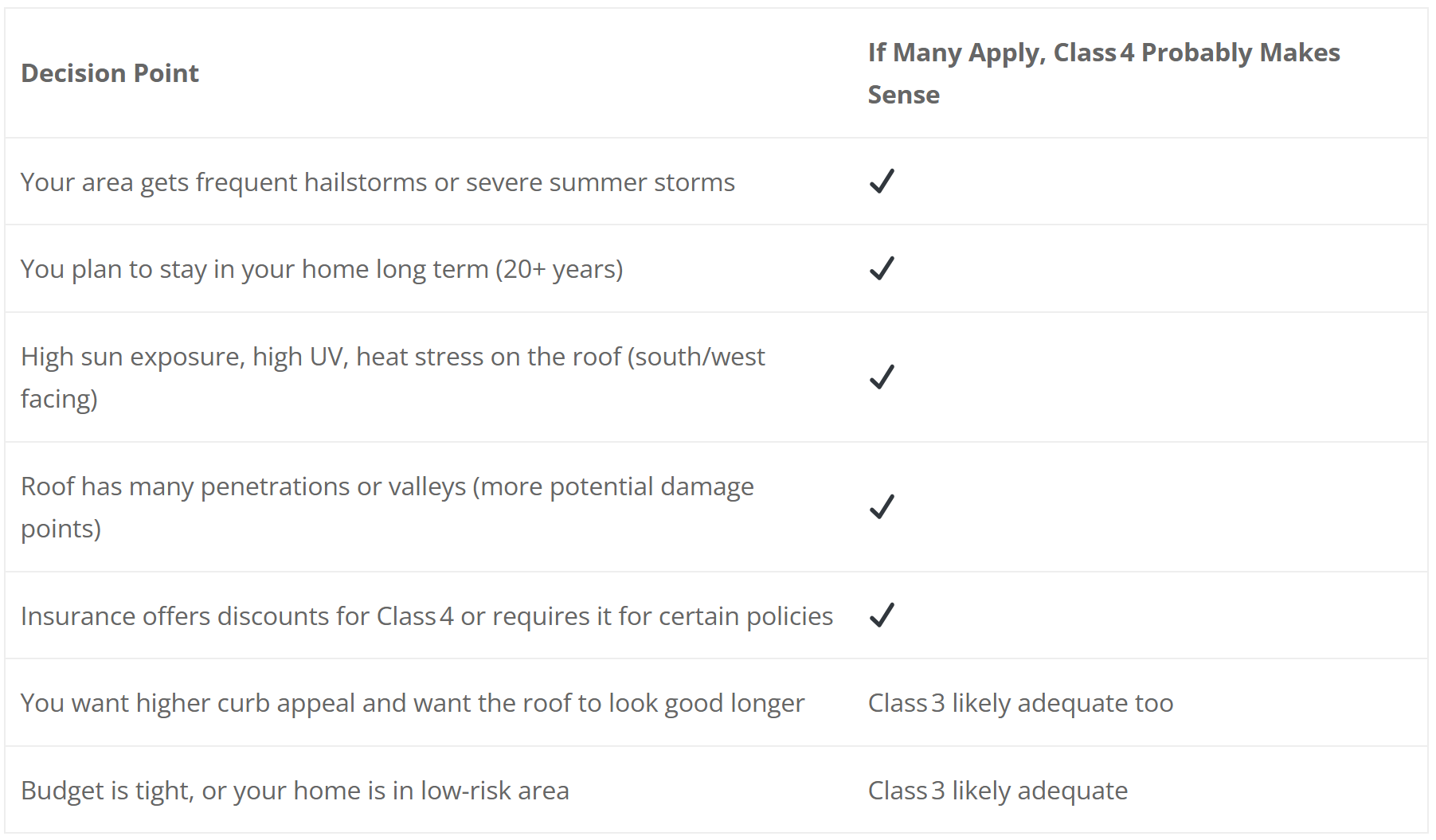
If many of those boxes are checked, ClimateFlex (Class 4) may be worth the investment. If few are, Landmark Pro (Class 3) still offers very good performance at lower cost.
Decoding the Class You Really Need
Understanding UL 2218 class ratings is essential when choosing a roof that will protect your home in Missouri or Illinois. Landmark Pro gives you a solid Class 3 rating: good resistance for many homes and weather scenarios. ClimateFlex steps that up to Class 4: higher protection against hail, durability, and likely better long‑term performance—especially in storm‑prone or severe weather areas.
Making the Smart Choice: Which Class Rating Matches Your Home Best
Every roof is different. When you weigh risk, budget, aesthetics, and your local weather, you’ll make the best decision.
At Gorilla Roofing, we pride ourselves on delivering top-notch roofing services with integrity and professionalism. Our team is licensed, insured, and committed to exceeding your expectations.
📞 Call us today at (636) 295-1212
🌐 Request a FREE roofing estimate
For expert assistance and personalized plans, contact Gorilla Roofing today. We’ll show you which shingles meet your needs, review class ratings, cost, and performance, and help you decide whether Class 3 or Class 4 is the right fit.
Let’s make your roof more than just a cover—it’ll be protection you can trust.

